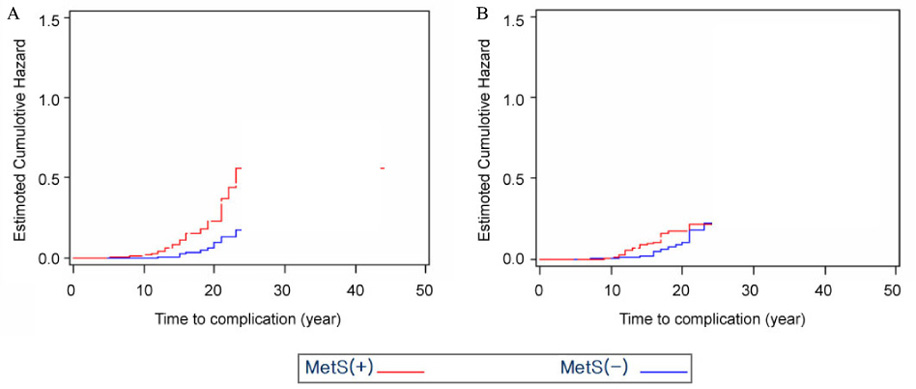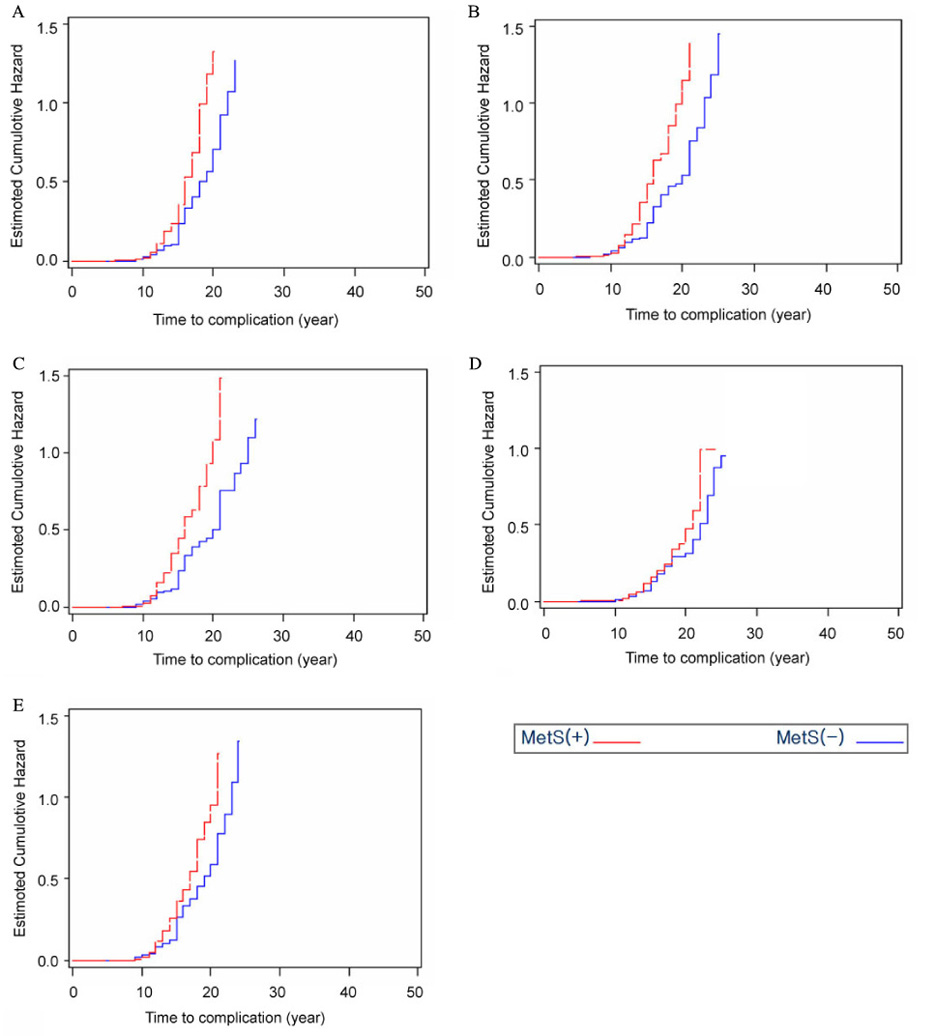Korean Diabetes J.
2009 Oct;33(5):392-400. 10.4093/kdj.2009.33.5.392.
Relationship Between Metabolic Syndrome and Risk of Chronic Complications in Koreans with Type 2 Diabetes
- Affiliations
-
- 1Department of Internal Medicine, Korea University College of Medicine, Seoul, Korea. cdongs@kumc.or.kr
- 2Department of Internal Medicine, Hallym University College of Medicine, Seoul, Korea.
- 3Department of Internal Medicine, Yonsei University Wonju College of Medicine, Wonju, Korea.
- KMID: 2231146
- DOI: http://doi.org/10.4093/kdj.2009.33.5.392
Abstract
- BACKGROUND
We examined the relationships between components of metabolic syndrome at the time of diagnosis of type 2 diabetes, and the development of chronic complications in Korean patients with type 2 diabetes.
METHODS
The medical records of patients with type 2 diabetes who had undergone treatment for at least five years prior were collected from 10 general hospitals in Korea. Among a total of 1,418 patients reviewed for possible inclusion in this study, 603 patients were selected, and the occurrence of complications among these patients was evaluated.
RESULTS
Among the 603 patients (male, 253; female, 350), 154 males (60.8%) and 266 females (76.0%) were diagnosed with metabolic syndrome at the time of initial diagnosis of type 2 diabetes. The incidence of chronic complications (average follow-up 15.2 +/- 4.9 years) included 60 cases of coronary artery disease (CAD), 57 cases of cerebrovascular accident (CVA), 268 cases of diabetic retinopathy (DR), 254 cases of diabetic nephropathy (DN), and 238 cases of diabetic peripheral neuropathy (DPN). As compared to patients without metabolic syndrome, the adjusted relative risks (95% CI) of incidental diabetic complications in patients with metabolic syndrome were 3.28 (1.40~7.71) for CAD, 2.04 (0.86~4.82) for CVA, 1.53 (1.10~2.14) for DR, 1.90 (1.29~2.80) for DN, and 1.51, (1.06~2.14) for DPN. With the addition of just one constituent of metabolic syndrome, the relative risk of developing CAD, CVD, DR, DN, and DPN increased by 2.08 (95% CI, 1.27~3.40), 1.16 (0.80~1.66), 1.09 (0.93~1.26), 1.29 (1.06~1.57) and 1.06 (0.87~1.26), respectively.
CONCLUSION
Metabolic syndrome in Korean patients with type 2 diabetes increases the risk of developing both macrovascular and microvascular complications.
MeSH Terms
Figure
Reference
-
1. Bonora E, Targher G, Formentini G, Calcaterra F, Lombardi S, Marini F, Zenari L, Saggiani F, Poli M, Perbellini S, Raffaelli A, Gemma L, Santi L, Bonadonna RC, Muggeo M. The metabolic syndrome is an independent predictor of cardiovascular disease in type 2 diabetic subjects: prospective data from the Verona Diabetes complications study. Diabet Med. 2004. 21:52–58.2. Ford ES. Risks for all cause mortality, cardiovascular disease, and diabetes associated with the metabolic syndrome: a summary of the evidence. Diabetes Care. 2005. 28:1769–1778.3. Alexander CM, Landsman PB, Teutsch SM, Haffner SM. NCEP-defined metabolic syndrome, diabetes, and prevalence of coronary heart disease among NHANES III participants age 50 years abd older. Diabetes. 2003. 52:1210–1214.4. Mykkanen L, Kuusisto J, Pyorala K, Laakso M. Cardiovascular disease risk factors as predictors of type 2 diabetes mellitus in elderly subjects. Diabetologia. 1993. 36:553–559.5. Haffner SM, Valdez RA, Hazuda HP, Mitchell BD, Morales PA, Stern MP. Prospective analysis of the insulin resistance syndrome(Syndrome X). Diabetes. 1992. 41:715–722.6. Fujimoto WY, Bergstrom RW, Newell-Morris L, Leonetti DL. Nature and nurture in the etiology of type 2 diabetes mellitus in Japanese Americans. Diabetes Metab Rev. 1989. 5:707–725.7. Hamman RF, Franklin GA, Mayer EJ, Marshall SM, Marshall JA, Baxter J, Kahn LB. Microvascular complications of NIDDM in Hispanics and non-Hispanic Whites. Diabetes Care. 1991. 14:655–664.8. Thompson TJ, Hegazy EM, Sous ES, Badran A, Herman WH. The onset of NIDDM and its relationship to clinical diagnosis in Egyptian adults. Diabet Med. 1996. 13:337–340.9. WHO. Prevalence of small vessel and large vessel disease in diabetic patients from 14 centres. The World Health Organization multinational study of vascular disease in diabetics. diabetes drafting group. Diabetologia. 1985. 28:615–640.10. Nam JW, Lee SH, Lee HJ, Han JH, Kim JG, Ha SW, Kim BW. The prevalence of chronic complications in non-insulin dependent diabetic patients. J Korean Diabetes Assoc. 1999. 23:702–715.11. Ko KS, Oh TG, Kim CH, Park KS, Lee MK, Kim SY, Cho BY, Lee HK, Koh CS, Min HK. A clinical study on the complications of non-insulin-dependent diabetes mellitus in Korea. J Korean Diabetes Assoc. 1991. 15:257–262.12. Min HK. The clinical characteristic of diabetes mellitus in Korean. J Korean Diabetes Assoc. 1992. 16:163–174.13. Hong YS, Hong LZ, Lee JS, Jung BS, Kim SW, Song CS. The clinical observation of diabetic complication. J Korean Diabetes Assoc. 1990. 14:85–90.14. Lee YJ, Tsai JC. ACE gene insertion/deletion polymorphism associated with 1998 World Health Organization definition of metabolic syndrome in Chinese type 2 diabetic patients. Diabetes Care. 2002. 25:1002–1008.15. Lee SH, Kang ES, Lee KE, Jin HD, Choi SH, Kim DJ, Ahn CW, Cha BS, Lim SK, Lee HC, Huh KB. Insulin resistance can predict the risk of metabolic syndrome. J Korean Med Assoc. 2002. 63:1–7.16. Mun MG, Jo YM, Jeong HS, Kim GW, Park YJ, Jang HC, Sin CS, Park KS, Kim SY, Lee HG. The prevalence of metabolic syndrome and its relation with chronic complications in Korean type 2 diabetic patients. J Korean Soc of Lipidology and atherosclerosis. 2003. 13:382–391.17. NCEP expert panel. Executive summary of the third report of the national cholesterol education program(NCEP) expert panel on detection, evaluation, and treatment of high blood cholesterol in adults(adult treatment panel III). JAMA. 2001. 285:2486–2497.18. Alberti K, Zimmet P, Consultation W. Definition, diagnosis and classification of diabetes mellitus and its complications. Diabetic Med. 1998. 15:539–553.19. The Metascreen Writing Committee. The metabolic syndrome is a risk indicator of microvascular and macrovascular complications in diabetes. Diabetes Care. 2006. 29:2701–2707.20. UKPDS Group. Efficacy of atenolol and captopril in reducing risk of macrovascular and microvascular complications in type 2 diabetes. UKPDS 39. BMJ. 1998. 317:713–720.21. UKPDS Group. Tight blood pressure control and risk of macrovascular and microvascular complications in type 2 diabetes: UKPDS 38. BMJ. 1998. 317:703–713.22. Guzder RN, Gatling W, Mullee MA, Byrne CD. Impact of metabolic syndrome criteria on cardiovascular disease risk in people with newly diagnosed type 2 diabetes. Diabetologia. 2006. 49:49–55.
- Full Text Links
- Actions
-
Cited
- CITED
-
- Close
- Share
- Similar articles
-
- Clinical Predictive Factors for Metabolic Syndrome in Obese Children and Adolescents
- Prevention of Metabolic Syndrome
- Sex differences in Risk of Cardiovascular Disease, Depression and Self-Care Activities in Type 2 Diabetes with Metabolic Syndrome
- Type 2 diabetes mellitus and metabolic syndrome
- Cardiovascular Risk of Gestational Diabetes Mellitus



